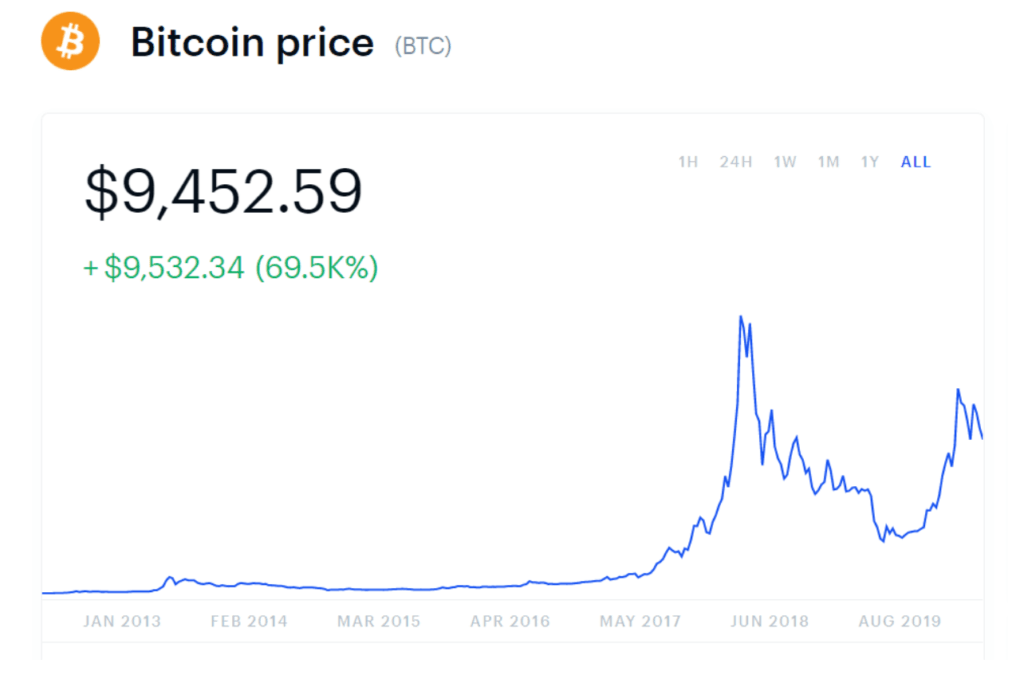Featured
A guide to aggressive investing in speculative assets
Aggressive investing is a strategy to turbo-charge your investment returns. With new platforms launching regularly, there are speculative investing opportunities in stocks, real estate, lending, forex, crowdfunding, cryptocurrency and more. For the aggressive investor, get ideas for speculative assets. Decide if aggressive investing is for you after learning the risks and how much to invest.

Aggressive investing includes penny stocks, bitcoin, currency trading and many more strategies that offer the opportunity for high returns. The downside to aggressive investing is the possibility of large losses. Younger investors with a strong stomach are appropriate candidates for aggressive investing in speculative assets.
Find out about speculative investing, its pros and cons, and whether reaching for large gains is the right investment path for you.
Is speculative trading for you?
With the popularity of bitcoin, cryptocurrency, crowdfunding, and peer-to-peer lending, investing has gone from just stocks and bonds to vast investment choices.
I’m a diehard conservative passive investor, with a diversified low fee index fund portfolio. Yet, despite my traditional investing approach, speculative investments, with their prospects of higher returns is alluring.
I’ve been a recent guest on the Money Tree Podcast where we’ve covered pot and space investing, two speculative stock plays. And, I included a segment about investing in cryptocurrency in a recent US News and World Report investment article.
With the promise of massive returns, I’ve been thinking about what percent of an investor’s portfolio should be allocated to speculative stocks, bonds, crypto, crowdfunding and more.

What are speculative investments?
Financial speculation promises higher returns in exchange for the promise of higher returns. When shooting for sky-high investment returns, like more than 10% annually, be prepared for the possibility of losing all or a majority of your investment.
Speculative trades include investments such as:
- Cryptocurrency
- IPOs
- Crowdfunding
- Peer-to-peer lending
- Forex
- Derivative or hedging strategies
- Penny stocks
- High yield bonds and bond funds
- Venture capital
What is the difference between speculation vs investing?
Investing vs speculating involves risk and probabilities.
The stock market has yielded an average return of north of 9% over decades and bonds averaged approximately 5%. Investing in a diversified portfolio of stocks and bonds both individually and through mutual and exchange-traded funds, for long term profits is considered investing.
Investing typically yields positive long term investment returns and offers a reasonable possibility of loss. Some investments offer dividends or cash flow, to cushion any declines in the investment’s value.
Speculative investments promise higher returns than typical stocks and bonds and are riskier. The speculative investment decision requires an investor to be willing to lose a large portion of their initial investment, in exchange for the possibility of outsized returns.
How much of your portfolio should be speculative?
Jake at I Heart Budgets asks, “If passive investing, what percentage of your portfolio would you allocate for “speculative investments”, like single tech stocks and such?”
Whether you’re a risk-seeking aggressive investor or a conservative type, you might want to allocate some portion of your portfolio to speculative investments.
The only criterion for a speculative investor is the willingness to lose all or most of an investment in exchange for great profit potential. That means, if you’re near retirement, or have a limited investment portfolio, you probably don’t want to speculate.
When considering investment vs speculation, realize that investing typically wins.
It’s helpful to understand your probability of making a killing with speculative investments. Hint: it’s lower than you might think.
Mark Hulbert, respected creator of the Hulbert Financial Digest reported in a legacy Wall Street Journal article “Can Market Timers Best the Index?” that during the last two market cycles, the 20 best market timers reduced portfolio volatility by 25 percent. But, had these same investors just bought and held a portfolio invested 80% in stocks and 20% in bonds, they would have earned a higher return with equivalent risk as to the market timers. I wrote more about passive portfolio management versus active trading in “Is Buy and Hold Finished?”
Before considering what percent to invest in speculative investments, take a quick risk quiz and figure out your risk tolerance. If you can’t tolerate big investment losses, you probably shouldn’t consider speculative investments.
Even if you love researching investments and looking for an arbitrage opportunity (chance to beat the market), consider your chances of long term success. It’s very low. One reason for the decline in success of active traders; today, investors aren’t competing against other traders. They are competing against complicated computer programs, who have no emotions with which to contend. In most cases, the machines are going to win over the individual traders.
So here’s an alternative if you want to try your luck with speculative investments or an active trading strategy. Put a small part of your investments in speculative assets like bitcoin or individual stocks.
Speculative investments-my secrets
I’ve invested in many individual stocks and speculative investments and have experienced the high of a stratospheric gain. Although not particularly speculative today, I bought Oracle in the 1990s. I paid a price in the teens and watched it top out above $100. I sold most of my position for a heady profit. On the other hand, I bought Nokia for $31 and sold it at $4. That wasn’t fun!
For those of you who think, “Invest in high dividend funds dividend-paying stocks and you can’t lose”, read why that isn’t always a perfect strategy. I invested in a limited partnership for a private airplane rental company and received a 12% dividend payment. The investment was required by law to pay out all earnings in dividends. Sounds great, doesn’t it? It was wonderful until the price of the limited partnership ultimately dropped 75%. I didn’t actually lose money on that investment since, over time, I recouped more than my original investment in dividends. But that investment demonstrates what can happen when you reach for the dividend sky.
At present, I invest in peer to peer lending through both Prosper and Lending Club. I have a small percent of our total net worth invested in this risky asset class. With defaults mounting and returns plummeting, I’m transitioning away from peer-to-peer lending.
I haven’t tried bitcoin or any of the crowdfunding real estate platforms yet, but I continue to think about them.
What percent of your total investment portfolio should be invested in speculative assets?
The percent you should invest in speculative assets depends upon the size of your portfolio, your age, and your risk tolerance.
What is your risk tolerance?
First question is to ask yourself how you will feel if you lose 100 percent of your speculative investment. That is possible with speculative investments. Bitcoin is trading at $9,000 in late August 2019. If you bought on June 25th, 2019 at $12,643, you’d have lost 25% of your investment in two months!
Use your response to that question to guide your speculative asset investment decision.
If you don’t mind risk and can still sleep if your portfolio makes a double-digit fall, then consider a maximum of 10 percent in speculative assets or individual stocks. It also helps if you are younger than age 40, when choosing speculative trading. If you’re younger, you have many years of earnings to make up your losses.
For most individuals, I wouldn’t suggest investing more than 5% of your net worth in risky assets. If you have a growing portfolio and you lose all of your money in your speculative investment, a 5% loss shouldn’t ruin you. And if you can’t afford to lose most or all of the speculative investment, instead of aggressive investing, go back to a more conservative asset allocation.
Obviously, if you have a large investment portfolio, then you can invest as much as you can afford to lose in speculative investments.
If you’re young, have a good steady job and a desire for big profits, go on and reach for the stars. Just be prepared for a rocky road and possible losses.
Zvi Bodie, the author of Risk Less and Prosper and the widely adopted academic finance book, Investments, authored with Kane and Marcus, is risk-averse. He has almost his entire portfolio invested in inflation-protected bonds and treasury inflation-protected securities.
How much to invest in speculative investments
As in most of investing, there is no one right answer. Clearly evaluate your personal situation to decide whether to invest in any speculative assets.
Furthermore, educate yourself so you know about the risks you are facing. Before I invested in the peer to peer lending platform, I read the Securities and Exchange Commission (SEC) documents. I focused on the risk section. There are great risks in this type of investing!
Be aware of the psychological pull to go with the crowd. Someone is always touting the new market timing system or forex or make it rich with options. Think and evaluate before using any of your hard-earned money for aggressive investing. And evaluate from whom you are getting your investment advice.
(Featured image by DepositPhotos)
—
DISCLAIMER: This article expresses my own ideas and opinions. Any information I have shared are from sources that I believe to be reliable and accurate. I did not receive any financial compensation for writing this post, nor do I own any shares in any company I’ve mentioned. I encourage any reader to do their own diligent research first before making any investment decisions.

-

 Impact Investing2 weeks ago
Impact Investing2 weeks agoChristmas Plastic Waste and the Path to Circular, Low-Emission Solutions
-

 Africa5 days ago
Africa5 days agoDamane Cash and FMSCD Partner to Enable Cash Advance in Exchange Offices
-

 Crowdfunding5 hours ago
Crowdfunding5 hours agoGörlitz Christmas Crowdfunding Campaign Exceeds All Goals
-

 Business2 weeks ago
Business2 weeks agoThe TopRanked.io Weekly Digest: What’s Hot in Affiliate Marketing [Super Partners Review]
























